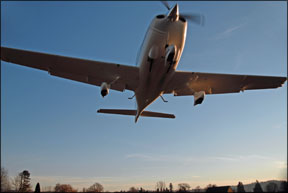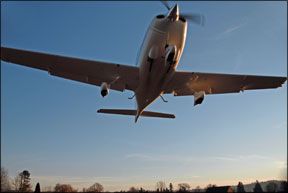If you were lucky, your primary flight instructor taught you that before you could learn how to land, you had to learn how to not land. This is an important concept worthy of discussion as we enter into the busy spring and summer flying season, when pilots crawl out of hibernation to fly laps around a gusty racetrack, leaving their rusty skills in the dust-or not. As a single-engine airplane flight instructor serving members of my home airports flying clubs, Ive learned there are many ways to safely bring an airplane back to 288 earth, though some are more elegant than others. But the one maneuver that shows me for certain whether an individual is ready for his or her first solo or is worthy of a flight review endorsement is the go-around, or aborted landing. The go-around is a pure, unadulterated stick and rudder maneuver that requires a heightened sense of the airplanes behavior as it moves through the air. It requires the pilot to react instinctively and precisely. When done properly, its a display of skill that makes me say to myself, “I can be this persons happy passenger. Id let my husband fly with this person.” Done poorly, and its a sign of trouble on the horizon. How not to go around Last summer, I helped organize a spot-landing contest at my home airport. It was a sunny day and everyone was having a grand time trying to plant the mains on the first few inches of the touchdown zone, until the wind began to swirl over the trees that line the edge of the runway. Judges and spectators watched in horror as one contestant bungled his approach and nearly stalled on his go-around attempt. The airplane seemed to hang precariously in space for an awfully long time, drifting to the left toward the trees, before the pilot finally lowered the nose, raised the flaps, remembered what the rudder pedals were for and climbed to safety. In an effort to prevent a repeat performance at this summers contest, I will host a mandatory pre-flight briefing for participants on safe pattern procedures, with an emphasis on the proper execution of a go-around. This is a skill that pilots take for granted because most approaches result in a landing on the first try. Pilots are quick to forget that unless the plane is on fire or the engine just quit, they dont have to land right away. It is important to remember, when the airplane is configured for landing, it is in a rather vulnerable position. Therefore, so are you. Final approach in most light single-engine airplanes is flown with 30 degrees of flaps, a low-to-idle power setting and with the airplane trimmed for an airspeed that is slightly above its full flaps, zero-bank stall speed (about 1.3 V
If the pilot decides-for whatever reason-that landing after that approach is not a good idea, an immediate go-around is necessary. This can occur even after one or both mains have already touched the ground, such as when an unexpected gust of wind makes directional control dicey. Either way, how the pilot responds during the next few seconds is critical. The airplane must rapidly and accurately be converted from a low-power, high-drag configuration to a high-power, low-drag configuration. The pilots principal job is to keep the airplane flying with positive control throughout this transition.
Get moving
The first order of business is to apply full power, because without it the airplane will continue to lose lift. The aircraft is operating in a flight condition commonly referred to as the backside of the power curve: With flaps and, perhaps, landing gear hanging out in the breeze, there is so much induced drag that additional power, not just a decrease in angle of attack, is required to overcome it. Any increase in angle of attack at this point will lead to a greater sink rate and, eventually, a stall. This is where unwary pilots like our hapless landing contest participant get themselves into trouble.
Just like your home computer, the airplane is a stupid machine-put garbage in, get garbage out. Somewhere out on final, you told your trusty bird to glide to the runway at 65 KIAS with little or no power and minimal control input from you. Thats all well and good until a deer-or another airplane-darts out onto the runway. When you apply full power for the go-around, then, the airplane wants to dutifully keep flying at 65 knots, but the only way it can do that without input from you is by pitching up, which it does rather dramatically. Depending on the airplane you fly, it can take quite a bit of forward pressure on the yoke to maintain a level pitch attitude at that moment.
Flip those flaps
Almost simultaneously, as soon as the throttle is full forward, the pilot of an airplane with electrically actuated flaps must reach over for the lever and move it up. Doing so quickly will relieve some of the pressure you are holding on the yoke as drag decreases and lift increases, though you will still need to trim nose-down at some point as you gain speed. Remember, the airplane was trimmed to fly at final approach speed and now you are trying to accelerate to some speed thats at least your airplanes best angle of climb speed (V
x) or, preferably, the best rate of climb speed (Vy).Many manufacturers call for the flaps to be retracted to 20 degrees immediately, then to 10 degrees after the airplane accelerates to a certain airspeed, and retracted completely once obstacles are cleared. This makes sense, but staring at the airspeed indicator and waiting for these magic numbers to appear during a go-around is impractical. Whats really important is looking out the window while maintaining positive physical pressure on the controls throughout the transition.
The FAAs
Airplane Flying Handbook says that, “a sudden and complete retraction of the flaps could cause a loss of lift resulting in the airplane settling to the ground.” In certain situations in certain airplanes, this is true-especially those with manually activated flaps, where with one downward swoosh of your arm on that “parking brake” lever you can transform your ride from flying machine to lawn dart in an instant. However, electric flap retraction does not really happen quite so suddenly. It takes the motor several seconds to move the flaps up 10 degrees, so if the pilot pulls the lever up from 30 degrees to zero in one motion, by the time the flaps get to 20 degrees the plane should have accelerated to a safe airspeed if positive pressure on the controls is maintained.Also consider that in gusty conditions when go-arounds are likely to be executed, it can be difficult if not impossible to get the little electric flap handle into the 20-degree detent while you and the airplane are bouncing around in the turbulent low-level air. In such conditions you might accidentally move the lever to zero, so its a good idea to try this at a safe altitude in your airplane first before attempting this over the runway, to observe how your airplane reacts. It might work for you in your airplane, and then again it might not. Better to find out before you actually fat-finger the flap lever on a gusty day.
You can practice this at altitude by setting up for a power-off stall from a stabilized descent with full flaps at your airplanes recommended final approach airspeed. Reduce the power to idle as you pitch up for the flare, and when the stall warning goes off (as it would just prior to touchdown on the runway; dont let the stall actually occur), note your altitude and immediately execute a go-around by applying full power and retracting the flaps to zero degrees. Maintain enough elevator pressure to keep the stall warning off and note whether you are able to establish a positive rate of climb without dipping below your starting altitude. If you can do this at altitude, you should be able to do it over the runway, where if you are low enough you may even have the benefit of ground effect to help you accelerate.
The flaps in my flying clubs 1975 Cessna 172M are electrically actuated and extend to 40 degrees. While those extra 10 degrees of flaps are a handy tool for making steep approaches into very short fields, they can come back to bite a pilot on the go-around if he is not prepared to deal with all of that extra drag. Ten degrees of flaps provide some lift and also some drag (which is why we use them in soft- and short-field takeoffs, to get a bit of extra lift without much of a drag penalty), but 40 degrees of flaps provide nothing but drag.
The flap handle in that airplane must be held continuously to retract the flaps, because there are no detents to mark each 10-degree increment. Perhaps yours work the same way. This means that during a go-around from an approach with 40 degrees of flaps, the pilot must quickly push in the throttle and carburetor heat knobs and then reach over for the flap lever and hold it up with one hand while maintaining positive pressure on the yoke with the other. Unless you are an acrobat or have a co-pilot aboard, there is no way to manipulate the throttle and the flap lever at the same time. Make sure the throttles friction lock is set tight once the knob is all the way in, perhaps even reaching over with your thumb to check that it hasnt slipped out.
Happy Feet
Then there is the issue of proper rudder use during a go-around. All of that engine power is working to get you airborne but, meanwhile, the torque and the propellers P-factor is also trying to yaw the nose to the left. This is another reason why go-arounds need to be done mostly by feel without looking at the airspeed indicator or the flap lever. You need to keep your scan outside to make sure you stay on the centerline and clear of obstacles.
Recently, I encountered some unexpected but nonetheless insane wind shear while trying to land at my home airport, and had no choice but to go around. The winds were blowing variably across the runway, reported at about 13 knots gusting to 20-challenging but not at first glance impossible to tackle. Tracking the centerline was surprisingly easy, but the ride down final approach was rougher than anything Id ever felt before. One moment it felt as if I were flying into an ocean wave, and the next moment the controls would get mushy.
I came in about 10 knots fast on final to mitigate the shear, with just 10 degrees of flaps to soften the effects of the gusts and minimize the drag Id have to overcome if I aborted the approach. I jockeyed the power and pitch to maintain positive control into the flare, but that little voice inside me said there was no way I was going to get the wheels onto the ground without popping a tire or worse. I decided that landing on my home turf was not an option that afternoon, so I carefully climbed away and landed uneventfully at a nearby alternate. My husband picked me up and I lived to retrieve the aircraft the following day.
If any of this makes you uncomfortable, then maybe its time to call up your friendly neighborhood flight instructor and practice go-arounds from various points in the approach. To get the most out of the session, pick a lightly gusty day with a bit of a crosswind. Youll be amazed at how much better your landings will be once you master the art of not landing.
Meredith Saini is a freelance aviation writer and flight instructor flying from the Gaithersburg, Md., area.




